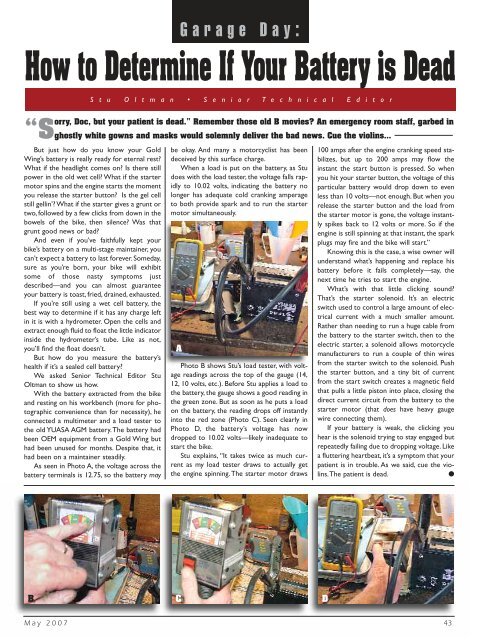to view pdf file of current issue - Wing World Magazine Archives
to view pdf file of current issue - Wing World Magazine Archives
to view pdf file of current issue - Wing World Magazine Archives
You also want an ePaper? Increase the reach of your titles
YUMPU automatically turns print PDFs into web optimized ePapers that Google loves.
Garage Day:<br />
How <strong>to</strong> Determine If Your Battery is Dead<br />
S t u O l t m a n • S e n i o r T e c h n i c a l E d i t o r<br />
orry, Doc, but your patient is dead.” Remember those old B movies An emergency room staff, garbed in<br />
“Sghostly white gowns and masks would solemnly deliver the bad news. Cue the violins…<br />
But just how do you know your Gold<br />
<strong>Wing</strong>’s battery is really ready for eternal rest<br />
What if the headlight comes on Is there still<br />
power in the old wet cell What if the starter<br />
mo<strong>to</strong>r spins and the engine starts the moment<br />
you release the starter but<strong>to</strong>n Is the gel cell<br />
still gellin’ What if the starter gives a grunt or<br />
two, followed by a few clicks from down in the<br />
bowels <strong>of</strong> the bike, then silence Was that<br />
grunt good news or bad<br />
And even if you’ve faithfully kept your<br />
bike’s battery on a multi-stage maintainer, you<br />
can’t expect a battery <strong>to</strong> last forever. Someday,<br />
sure as you’re born, your bike will exhibit<br />
some <strong>of</strong> those nasty symp<strong>to</strong>ms just<br />
described—and you can almost guarantee<br />
your battery is <strong>to</strong>ast, fried, drained, exhausted.<br />
If you’re still using a wet cell battery, the<br />
best way <strong>to</strong> determine if it has any charge left<br />
in it is with a hydrometer. Open the cells and<br />
extract enough fluid <strong>to</strong> float the little indica<strong>to</strong>r<br />
inside the hydrometer’s tube. Like as not,<br />
you’ll find the float doesn’t.<br />
But how do you measure the battery’s<br />
health if it’s a sealed cell battery<br />
We asked Senior Technical Edi<strong>to</strong>r Stu<br />
Oltman <strong>to</strong> show us how.<br />
With the battery extracted from the bike<br />
and resting on his workbench (more for pho<strong>to</strong>graphic<br />
convenience than for necessity), he<br />
connected a multimeter and a load tester <strong>to</strong><br />
the old YUASA AGM battery.The battery had<br />
been OEM equipment from a Gold <strong>Wing</strong> but<br />
had been unused for months. Despite that, it<br />
had been on a maintainer steadily.<br />
As seen in Pho<strong>to</strong> A, the voltage across the<br />
battery terminals is 12.75, so the battery may<br />
be okay. And many a mo<strong>to</strong>rcyclist has been<br />
deceived by this surface charge.<br />
When a load is put on the battery, as Stu<br />
does with the load tester, the voltage falls rapidly<br />
<strong>to</strong> 10.02 volts, indicating the battery no<br />
longer has adequate cold cranking amperage<br />
<strong>to</strong> both provide spark and <strong>to</strong> run the starter<br />
mo<strong>to</strong>r simultaneously.<br />
A<br />
Pho<strong>to</strong> B shows Stu’s load tester, with voltage<br />
readings across the <strong>to</strong>p <strong>of</strong> the gauge (14,<br />
12, 10 volts, etc.). Before Stu applies a load <strong>to</strong><br />
the battery, the gauge shows a good reading in<br />
the green zone. But as soon as he puts a load<br />
on the battery, the reading drops <strong>of</strong>f instantly<br />
in<strong>to</strong> the red zone (Pho<strong>to</strong> C). Seen clearly in<br />
Pho<strong>to</strong> D, the battery’s voltage has now<br />
dropped <strong>to</strong> 10.02 volts—likely inadequate <strong>to</strong><br />
start the bike.<br />
Stu explains, “It takes twice as much <strong>current</strong><br />
as my load tester draws <strong>to</strong> actually get<br />
the engine spinning.The starter mo<strong>to</strong>r draws<br />
100 amps after the engine cranking speed stabilizes,<br />
but up <strong>to</strong> 200 amps may flow the<br />
instant the start but<strong>to</strong>n is pressed. So when<br />
you hit your starter but<strong>to</strong>n, the voltage <strong>of</strong> this<br />
particular battery would drop down <strong>to</strong> even<br />
less than 10 volts—not enough. But when you<br />
release the starter but<strong>to</strong>n and the load from<br />
the starter mo<strong>to</strong>r is gone, the voltage instantly<br />
spikes back <strong>to</strong> 12 volts or more. So if the<br />
engine is still spinning at that instant, the spark<br />
plugs may fire and the bike will start.”<br />
Knowing this is the case, a wise owner will<br />
understand what’s happening and replace his<br />
battery before it fails completely—say, the<br />
next time he tries <strong>to</strong> start the engine.<br />
What’s with that little clicking sound<br />
That’s the starter solenoid. It’s an electric<br />
switch used <strong>to</strong> control a large amount <strong>of</strong> electrical<br />
<strong>current</strong> with a much smaller amount.<br />
Rather than needing <strong>to</strong> run a huge cable from<br />
the battery <strong>to</strong> the starter switch, then <strong>to</strong> the<br />
electric starter, a solenoid allows mo<strong>to</strong>rcycle<br />
manufacturers <strong>to</strong> run a couple <strong>of</strong> thin wires<br />
from the starter switch <strong>to</strong> the solenoid. Push<br />
the starter but<strong>to</strong>n, and a tiny bit <strong>of</strong> <strong>current</strong><br />
from the start switch creates a magnetic field<br />
that pulls a little pis<strong>to</strong>n in<strong>to</strong> place, closing the<br />
direct <strong>current</strong> circuit from the battery <strong>to</strong> the<br />
starter mo<strong>to</strong>r (that does have heavy gauge<br />
wire connecting them).<br />
If your battery is weak, the clicking you<br />
hear is the solenoid trying <strong>to</strong> stay engaged but<br />
repeatedly failing due <strong>to</strong> dropping voltage. Like<br />
a fluttering heartbeat, it’s a symp<strong>to</strong>m that your<br />
patient is in trouble. As we said, cue the violins.The<br />
patient is dead.<br />
●<br />
B<br />
C<br />
D<br />
May 2007 43

















